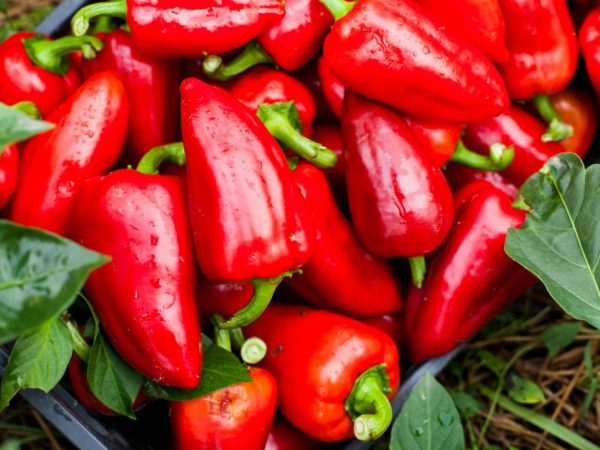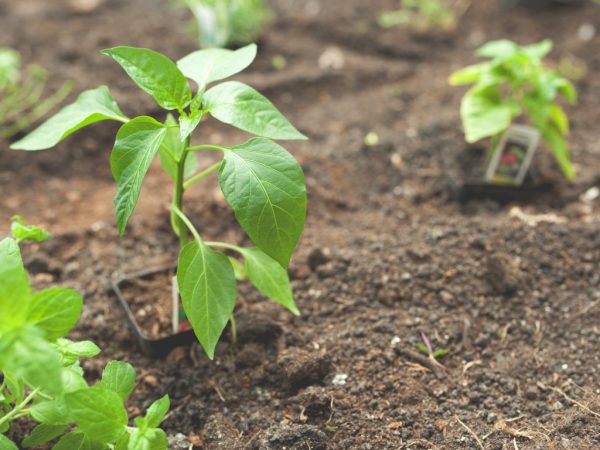Characteristics of the temp pepper variety
Hybrid pepper Temp medium early belongs to the category of nightshade garden crops. It has found applications in both industrial and home cooking.

Characteristics of the temp pepper variety
Characteristics of the variety
Pepper Temp f1 is early maturing. From disembarkation to technical maturity, 85-90 days pass. From germination to biological maturity - 100 days.
The Temp variety has excellent taste, it is resistant to:
- pests and diseases (tobacco mosaic, top rot);
- sharp changes in temperature (withstands up to -20 ° C);
- drought or excessive moisture;
- verticillary wilting, etc.
Sweet peppers of the Temp f1 variety have a high yield level. On average, from 1 sq. m is harvested from 4 to 6 kg if the vegetable crop grows in the open field. If the pepper is grown in a greenhouse or greenhouse, from 1 sq. m receive up to 10 kg of fruit.
Description of the bush
According to the description, the bush has a number of features:
- Average height (60-80 cm).
- Semi-spreading, power, good foliage, which does not require shaping and frequent pruning.
- Oval leaf shape, uniform development of the leaf plate.
- Pale green leaves.
Description of fruits
The Temp F1 variety is distinguished by sweet, juicy fruits. The type of vegetable is Hungarian. The surface is ribbed, in the form of separate lobules.
According to the description, the fruits of the Temp pepper have the following characteristics:
- size (weight of 1 fruit is 100-130 g);
- conical shape;
- drooping;
- fleshy;
- smoothness;
- glossiness.
Wall thickness - 4-5 mm. The number of chambers is from 3 to 4. At the beginning of ripening, the color of the fruit is light green, in the period of biological maturity - red.
Pepper Temp is great for fresh consumption and processing. It is used to make stuffed peppers, vegetable stews, soups, and grilled slices.
Sweet fruits are used for cold summer salads, vegetable smoothies, fresh juices. They are also suitable for conservation.
Care
Pepper care Temp F1 is the same as for other hybrid varieties. Seeds are selected first. After purchase, they are put in water and left for 5-10 minutes. Those seeds that go down can be left. Those that come up must be thrown away, because they are empty and will not sprout.
Seed preparation
Seeds are treated with manganese solution for preventive purposes. 5 g of potassium permanganate and diluted in 1 liter of water. The seeds are kept in solution for no more than 10-20 minutes, after which they are washed and dried.
Landing

It is important to keep a distance when landing.
Planting is carried out according to the scheme: 5-7 bushes per 1 sq. m. If you increase the planting density to 8-10 plants, the bushes will give a low-quality crop. The roots will intertwine, which will reduce disease resistance and make Temp peppers more vulnerable.
When planting, observe a distance of 30 cm between the bushes and 70 cm between the rows. The neck of the plant is not deepened into the ground so that decay does not occur.
Care procedures
| Name | Period or time | Description |
| Watering | Early morning, evening after sunset | Watering is carried out with warm, settled water. Frequency - 2-3 times a week.Watering is carried out only at the root. The entire plant is sprayed with drip irrigation every 2 weeks. During the period of heavy rains, they refuse additional watering. They are carried out only as the soil dries up. For peppers, temp is better dry than waterlogged soil. |
| Top dressing | Before sowing | Wood ash must be added to the ground along with the mullein. Each component is taken in an amount of 100-150 g and diluted in 10 liters of water. This is enough for 1 sq. m landing. |
| 10-14 days after planting | If the pepper is grown on a garden bed in the open field, bird droppings are added in a ratio of 1 to 20 to water. If the vegetable is grown in a greenhouse, add 20 g of ammonium nitrate, 35 g of superphosphate, 25-30 g of potassium sulfate, diluted in 10 liters of water. Let it brew for a day, after which it is brought under the root. This solution is enough for 8-10 bushes. | |
| 10 days after the second feeding | You need to focus on when the ovaries formed on the plant. Complex fertilizer is introduced. It consists of 15 g of superphosphate, 10 g of ammonium nitrate, 20-30 g of potassium. All components are diluted in a bucket of water. This amount of solution is enough to process 6-8 plantings. The dressing prepared according to this recipe is appropriate for the 4th and 5th feedings, that is, during ripening. The last dressing is applied 14 days before harvest. | |
| Mulching | Before freezing | This procedure is necessary to maintain a normal level of moisture in the ground and protect the plant from frost in winter. As mulch, they take straw, lime, humus, mulch paper, grass. When mulching, the root system remains intact and air exchange is improved. |
| Loosening the soil | One day after watering | Loosening is necessary to enrich the land with oxygen, which has a positive effect on the yield of the variety. The procedure is carried out every time after watering to remove the soil crust. |
| Harvest | End of July - mid-August | You don't have to wait for the fruit to turn bright red. They are torn off as soon as the size is 100-130 grams. It is recommended to harvest the fruits 2-3 times a week. Peppers ripen when placed in a dark, warm place for several days. |
Pests and diseases
Care errors can lead to the development of diseases.
Fusarium
An excess of moisture provokes the appearance of fusarium. When damaged, the leaves wither, acquire a pale shade, the process of photosynthesis stops. Infected bushes cannot be saved, so they are uprooted and burned.
Wet rot
The cause of this disease is excessive humidity, frequent watering in rainy weather. Initially, small dark spots appear on the fruits, after 3-5 days they affect most of the plant. As a result, the skin of the fruit dries up. It becomes watery, soft. You cannot eat such a vegetable. For prevention, the bushes are sprayed with a solution of copper sulfate once a month.
Pillar
Stolbur is the cause of twisted and fallen leaves. Because of it, the plant stops growing, the fruits become concave, aphids and mites may appear. To stop the stolbur damage, the bushes are dug up and removed. The soil where they grew is disinfected with Fitosporin or manganese solution.
Conclusion
Pepper variety Temp f1 is an early ripe, sweet hybrid with a yield of 6-10 kg per 1 sq. M. The fruits are sweet, juicy and fleshy. Caring for the vegetable is traditional and uncomplicated, making the crop popular with gardeners.


